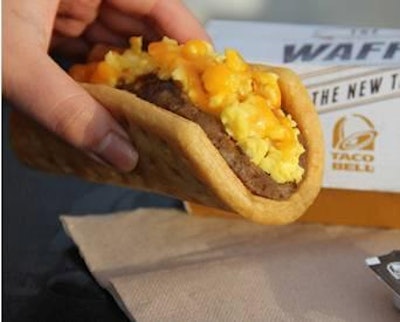
The latest U.S. quick-service restaurant (QSR) chain to make a big splash by adding breakfast service is Taco Bell. Eggs are a big part of the Taco Bell’s breakfast menu, as they have been at other chains that added new breakfast offerings in the past few years like Subway and Dunkin' Donuts. Even QSRs that have been serving breakfast for decades, like McDonald’s and Jack in the Box, have brought out new egg white sandwiches. With this flurry of promotional activity, why were egg servings in U.S. food service outlets 6 million dozen less in 2013 than in 2012?
John Howeth, foodservice and egg product marketing vice president, American Egg Board (AEB), said that the major reason for the decline in foodservice eggs sales has been the drop in per capita restaurant visits in the U.S. Howeth told the audience of the AEB’s Volumetric Egg Products Study webinar, that in 2007 there were 208 visits to restaurants per person in the U.S. and that in 2013 it was down to 193. So, over a six-year period restaurants lost about 4.5 billion visits. “That is a lot of egg servings that we were getting that we aren’t getting today,” he said.
Battling for breakfast
One of out of every 10 breakfasts in the U.S. is eaten away from home. Howeth said that in 2013 QSRs captured 85 percent of the total away-from-home breakfast business. Mid-scale restaurants, such as Denny’s and IHOP, come in second place, capturing 12 percent of the breakfasts eaten away from home. Howeth explained that the market share numbers reported are for breakfasts eaten at restaurants and don’t include breakfasts eaten at school or business cafeterias.
The breakfast business in QSRs continues to increase and was up 1 percent in 2013, or about 25 million servings. Howeth reported that QSRs’ breakfast servings have gone up by 7 percent in the past four years. Nearly three-quarters (74 percent) of all egg servings in restaurants are now sold at QSRs. Midscale restaurants accounted for 20 percent of egg servings in 2013, down from 24 percent in 2008.
Eggs per serving
All breakfasts are not the same, and the shift in market share from midscale restaurants to QSRs has not been good for total egg sales. Howeth reported that the average breakfast serving at a QSR has 1.12 eggs in it. “At midscale restaurants, like IHOP and Denny’s, the eggs per serving is closer to 2.5, based on the sale of Grand Slam platters and of other meals like that,” he said.
Midscale restaurants saw their share drop by 4 percent from 2012 to 2013, which represented a loss of 11 million dozen in egg sales. Howeth said the midscale segment is expected to continue to decline at a rate of 1-2 percent per year over the next decade while QSR business is expected to continue to grow.

















